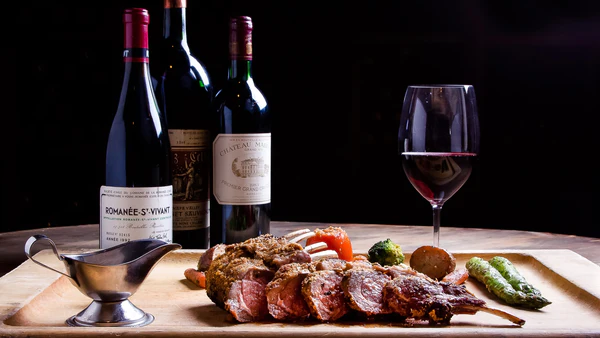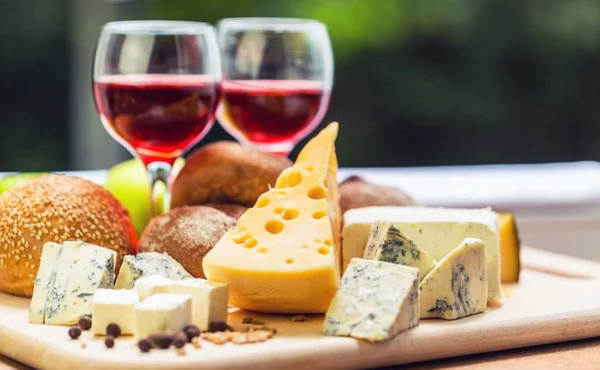Meat dishes
– smoked meat – white dry Riesling; Gewurztraminer (Gewurztraminer) …
Grilled meat
– White dry Riesling (Riesling) for pork; Gewurztraminer (Gewurztraminer); Red dry Bordeaux (Bordeaux); Côtes du Rhone (Cotes du Rhone); Anjou (Anjou).
– Red dry Bordeaux (Bordeaux) for veal; Graves; White dry Graves (Graves); Tokay Pinot-Gris (Tokay Pinot-Gris).
– Red dry Pauillac (Pauillac) for lamb; Saint-Estephe (Saint-Estephe); Graves; Carmenere (Carmenere); Saperavi

Wine and meat
Pork
– Pork loin boiled / baked / fried / grilled – Alsatian “Pinot Gris” and “Muscat”, Beaujolais Village, “Game” from Touraine, Tuscan red, Chilean “Merlot” and “Cabernet Sauvignon”;
– Baked pork – dry Vouvre, Rioja Reserve, Pinot Noir from the New World;
– Baked pork bone with honey – “Riesling”;
– Parma ham dry Lambrusco, Prosecco, “Game” from Tourena, young “Tempranillo”;
– Roast pork – Montepulciano d’Abruzzo, red wine from the Navarre region;
– Pork with prunes – Loire red wines, Caor, Corbet;
– pork sausage – red wines of the Rhône Valley region, Barbera;
– For pork Red dry Saint-Joseph (Saint-Joseph); Morgon (Morgon); Moulin-a-Vent (Moulin-a-Vent);
– White dry Vouvray (Vouvray) for pork pate.
Beef
– Boiled beef with carrots – Bordeaux red wines, Valpolicella Classico, Australian Shiraz;
– Stewed roast beef – Pomerol, Saint-Emilion, Hermitage, Shiraz and Pinot Noir from the New World;
– Beef jerky – Beaujolais, red wines of Languedoc, “Barbera”;
– grilled beef – Chilean “Merlot”;
– Burgundian beef – red wines of Burgundy, Barolo, Australian red wines;
– Wellington-style beef – good Burgundy, “Chatoneuf-du-Pap”;
– Creole-style beef – red “Côte du Rhône”;
– beef carpaccio – champagne and sparkling, Chardonnay, Cabernet Franc, Pomerol;
– For fried beef Red dry Pomerol (Pomerol); Saint-Emilion (Saint-Emilion); Cotes du Rhone Villages (Cotes du Rhone Villages); Chateauneuf-du-Pape (Chateauneuf-du-Pape);
– For baked beef Red dry Saint-Estephe (Saint-Estephe); Saint-Julien (Saint-Julien); Poyak (Pauillac);
– For beef stew with vegetables and peas Red dry Cotes-de-Bourg (Cotes-de-Bourg); Corbieres;
– Red dry Beaujolais (Beaujolais) for stewed beef; Morgon (Morgon); Moulin-a-Vent.
Veal
Red dry Côtes du Rhone (Cotes du Rhone); Graves; White dry Riesling (Riesling); Vouvray (Vouvray); Chardonnay (Chardonnay).
– veal liver – Italian “Merlot” and “Cabernet Sauvignon”;
– veal in white sauce, white wines of Alsace and northern Rhone Valley;
– baked veal – Italian white, red wines of the Loire Valley, Spanish red wines, Saint-Emilion.
Mutton
Red dry Graves (Graves); Saint-Estephe (Saint-Estephe); Poyak (Pauillac); Fronsac (Fronsac); Cahors; Morgon (Morgon); Moulin-a-Vent (Moulin-a-Vent); Chateauneuf-du-Pape (Chateauneuf-du-Pape); New Zealand Cabernet Sauvignon, Chilean Bordeaux, Georgian Saperavi;
– Baked lamb with thyme – New Zealand Cabernet Sauvignon;
– Shashlyk and Kebab – Greek red, mature Australian Cabernet / Shiraz;
– Stewed roast – French “Cabernet Sauvignon”
Cheese
Probably, it is difficult to find a person who does not like at least some kind of cheese. It is produced in France, Italy, Spain, Holland, Austria, Germany…
Cheese is a valuable source of protein, containing essential amino acids that our body cannot produce on its own. Cheese is rich in fats that give energy, and they improve the assimilation of other useful substances. Regular consumption of cheese will delay premature aging, the development of atherosclerosis and help fight cholesterol in the blood. In addition to all the listed advantages, cheeses contain vitamins. For example, vitamin A improves eyesight and immunity, and vitamin B2 improves appetite, relieves headaches and strengthens the nervous system, heart and liver. We warn you: excessive consumption of cheese will be a difficult test for the stomach.
It is also undesirable to use it after a rich fatty meal. 200 g of cheese per day is quite enough to fill the lack of vitamins in the body.
Wine and cheese
There are different opinions about the combination of cheese and wine. It turns out that combining wine and cheese is not a good idea, because the cheese destroys the aroma of the wine, according to wine expert Graham Halter. Here’s what he has to say about it: “People think there’s some glamor to this pairing, but the truth is, it’s clear that red wine and cheese is a terrible combination that most people in the wine business are well aware of. It’s a bit like the terrible fad of pairing chocolate with champagne. However, some strong varieties of cheese and white wines harmonize. However, the cheese is usually so spicy that it overpowers almost anything.” Many will not agree with such a categorical approach, but under certain conditions, this opinion is absolutely correct.

Scientists once asked professional tasters to try eight different types of cheese before they were introduced to four different options of inexpensive and expensive wines. It turned out that the eaten cheese “tamed” almost everything in the wine, including aroma, acidity and astringency, as a result, experts could not distinguish one wine from another.
In the case of a professional tasting, the main task is an adequate assessment of what is being tasted, and if something interferes with the assessment, it should be eliminated without resorting to experiments. In France, they say: “Cheese with a glass of wine is a pleasure worthy of kings!” It so happened that many of those who love cheese also love wine. Anyone who travels a lot will agree that cheese and wine from the same region, as a rule, not only do not interfere with each other, but also complement each other in the best way.
– Cream cheese, crème fraîche, mozzarella, mascarpone – fresh light dry whites – Frascati, Pinot Grigio;
– Goat cheese – Alsatian white wines, white Bordeaux, “Sauvignon Blanc”;
– Brie – champagne and sparkling, New Zealand “Sauvignon Blanc”, Sancer;
– Camembert – champagne and sparkling, “Sauvignon Blanc”, Chablis;
– Comte – Burgundian white, “Chardonnay”;
– Livaro – “Gewürztraminer”;
– Munster – “Gewürztraminer”;
– Epois – sweet “Riesling”;
– Parmesan – Valpolicella, Barolo, Barbaresco; Lambrusco;
– Pecorino Toscano – Chianti and other Sangiovese wines;
– Roquefort – Sauterne, Barsac, late harvest Alsatian wines;
– Gouda – “Zinfandel”;
– Cheddar – “Cabernet Sauvignon”;
– Stilton – light Port wine.
